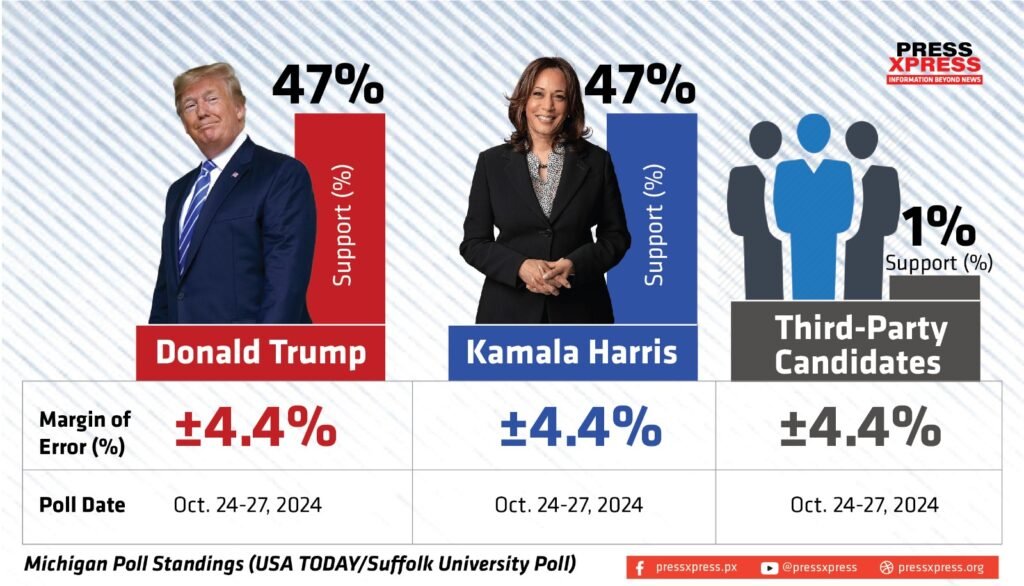As Election Day approaches, Michigan—a decisive swing state with 15 electoral votes—is emerging as one of the most closely watched battlegrounds. A USA TODAY/Suffolk University poll conducted between October 24-27 shows Vice President Kamala Harris and former President Donald Trump in a statistical tie, each securing 47% of likely voters. The race, with a margin of error of 4.4 percentage points, reflects Michigan’s importance in this election cycle and its critical role in deciding the outcome of the presidential race.

Michigan: A Historic Bellwether State
Michigan, known as part of the “Blue Wall” alongside Pennsylvania and Wisconsin, has a history of swinging between Democratic and Republican control in recent elections. Trump’s unexpected win in 2016 flipped Michigan red by a narrow margin, marking a significant shift in its political landscape. However, in 2020, Joe Biden reclaimed the state for the Democrats, winning with a 52% majority. This year, the political landscape in Michigan appears as fractured as ever, with Harris and Trump evenly matched. For both candidates, Michigan’s 15 electoral votes could tip the scales in an otherwise tight national race, and both campaigns are pulling out all the stops to secure this key state.

Kent County: The Bellwether for Michigan
Kent County, often viewed as a microcosm of Michigan, has mirrored statewide results in the last two presidential elections, making it a crucial area for both campaigns. The recent poll suggests that Harris has a slight edge over Trump in Kent County, leading by 47% to Trump’s 46%. Although within the 5.7-point margin of error, the result could be indicative of broader trends across Michigan. If Harris wins Kent County by a narrow margin, analysts suggest she may also carry the state—a pattern observed in previous elections. For both candidates, winning over undecided voters in Kent County could be key to securing Michigan’s electoral votes.

Third-Party Candidates: A Potential Game-Changer?
Though Harris and Trump are virtually tied in Michigan, third-party candidates—Robert F. Kennedy Jr., Jill Stein, and Cornel West—are collectively capturing about 1% of the vote. While these percentages seem negligible, in a tight race, even a single percentage point could prove pivotal. Kennedy, who initially withdrew from the race to back Trump, has had his name remain on the ballot following a Supreme Court decision. Political observers warn that votes for Kennedy or any third-party candidate could disrupt the race in Trump’s favor.
“In a race like this, where it’s tied and this close, even a 1% share for a third-party candidate could swing the outcome,” commented pollster David Paleologos, who directed the USA TODAY poll.
Voter Motivation at Record Highs
The poll reveals a striking level of voter motivation: 93% of respondents are very motivated to vote, and nearly half have already cast their ballots. This enthusiasm underscores the high stakes of this election, with Michiganders driven by a mix of strong economic, social, and ideological concerns. Both candidates face significant disapproval ratings, with 56% of respondents disapproving of Biden’s performance and 50% disapproving of Trump’s.

Such high disapproval rates may indicate a willingness among voters to seek alternatives, which could either work against the traditional two-party dynamics or solidify loyalties, depending on voter turnout on Election Day.
The Economy and Social Unrest Shape Voter Sentiment
Economic concerns and the desire for stability are driving voter sentiment in Michigan, as residents express frustration with inflation, housing affordability, and economic policies.
Harris, as the Democratic nominee, has positioned herself as a unifying force who pledges to work across party lines. Some Michiganders, like Linda Randle, a retired automotive industry employee, believe Harris’s economic and housing plans will benefit voters across the political spectrum. “Her policies will help Democrats, Republicans, and independents alike,” Randle shared, expressing a hope that the election might bring a renewed sense of unity to the state and country.
Trump, meanwhile, is drawing on his record of economic expansion, highlighting growth that many of his supporters associate with his time in office. This message resonates with parts of Michigan’s working-class population, particularly in regions that rely on the manufacturing industry. Despite disapproval rates faced by both parties, Trump’s message of economic resilience and national security is striking a chord among voters who value these issues. This strong connection with Michigan’s workforce could prove advantageous, especially in economically sensitive areas.

As one of seven crucial swing states, Michigan holds a unique position in this election. A win here for Harris would reinforce Democratic strength in the Midwest and uphold Michigan’s reputation as a key part of the Blue Wall. For Trump, regaining Michigan would signal a reaffirmation of his appeal to Midwestern voters and underscore his enduring influence within the Republican base. In the larger national context, Michigan’s results could set a precedent for other swing states, such as Wisconsin and Pennsylvania, which have historically aligned with Michigan’s voting trends.
Lastly, with only days remaining until Election Day, the USA TODAY/Suffolk poll highlights the unpredictability of Michigan’s political landscape, where even slight shifts in support could determine the state’s direction. Both Harris and Trump are positioned neck-and-neck, underscoring the importance of every vote. For Michigan, this election represents not only a contest between two candidates but also a moment to shape the national narrative, making it a state to watch closely as America heads to the polls.


